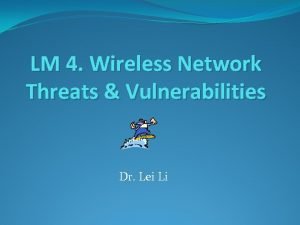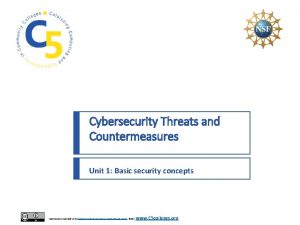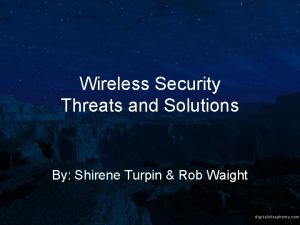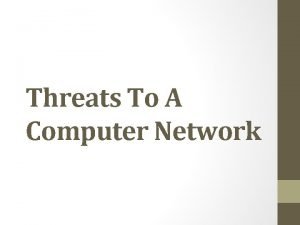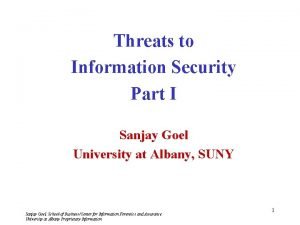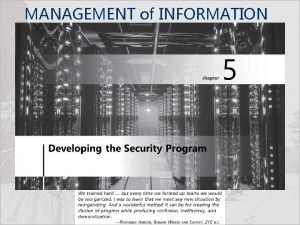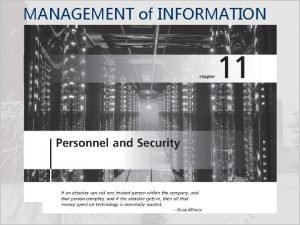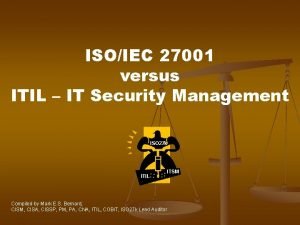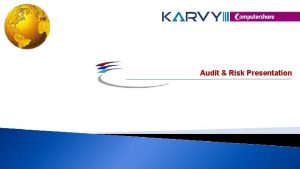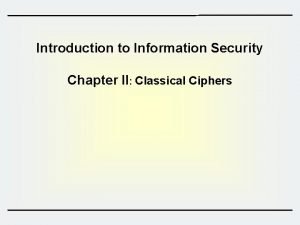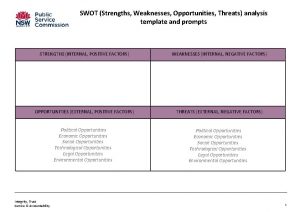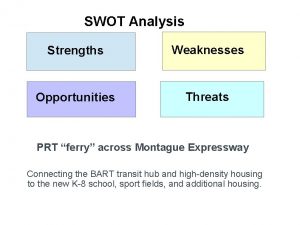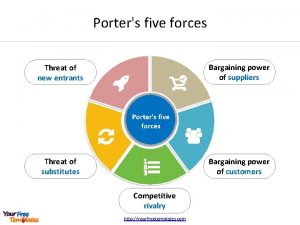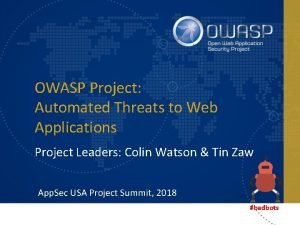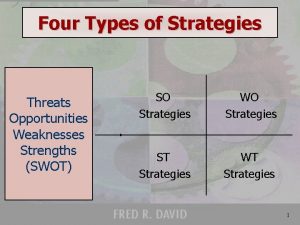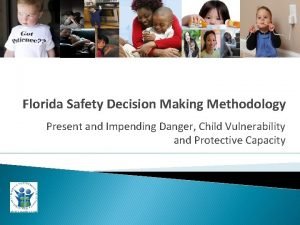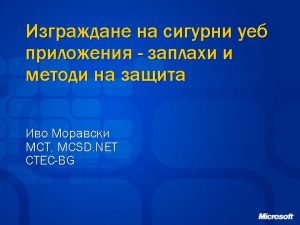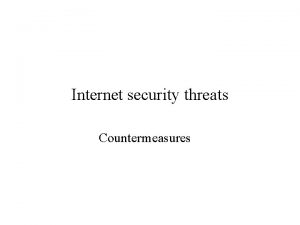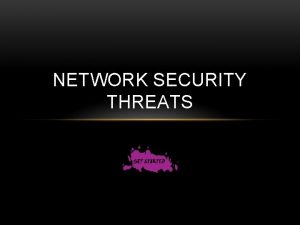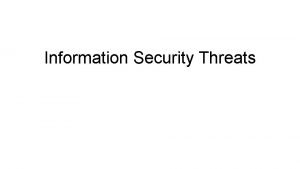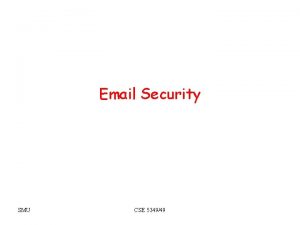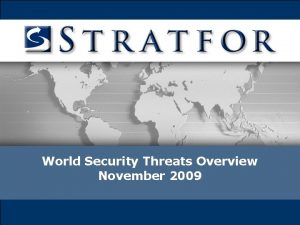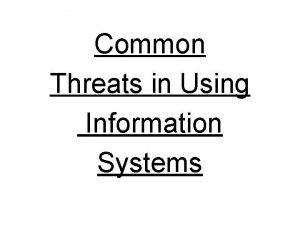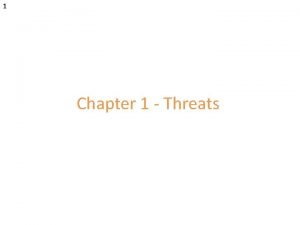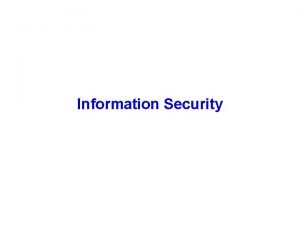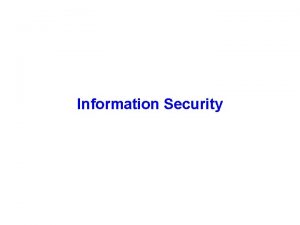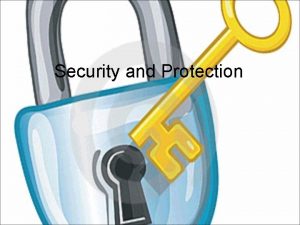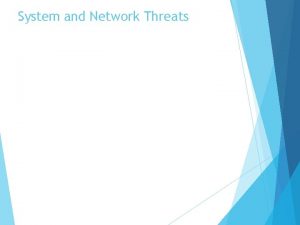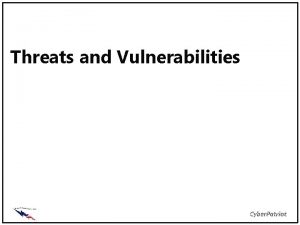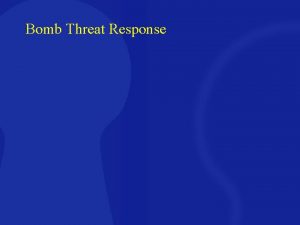Chapter 11 Information Security Management Agenda Security Threats































- Slides: 31

Chapter 11 Information Security Management

Agenda • Security Threats – Sources – Problems • Security Program – – – Senior Management’s Security Role Technical Safeguard Data Safeguard Human Safeguard Disaster Preparedness Incident Response

Sources of Security Threats • Human error and mistakes – – Employees and non-employees Accidental problems Poorly written application programs Poorly designed procedures • Malicious human activity – – Employees, former employees, hackers, and outside criminals Intentionally destroy data or other systems components Steal for financial gain Terrorism • Natural events and disasters – Acts of nature – Loss of capability, service, and recovery

Problems of Security Threats • • • Unauthorized data disclosure Incorrect data modification Faulty service Denial of service Loss of infrastructure

Unauthorized Data Disclosure • Pretexting: someone pretending to be someone else • Phishing: someone pretending a legitimate company and obtaining confidential data by email • Spoofing: IP spoofing and Email spoofing • Sniffing: intercepting computer communication • Drive-by sniffers: intercepting unprotected wireless network

Incorrect Data Modification • Human error – employees follow procedures incorrectly – procedures have been incorrectly designed • Hacking

Faulty Service • Incorrect system operation – Human procedure mistake • Usurpation – Unauthorized program in a computer system

Denial of Service • Human error • Malicious hacker • Natural disasters

Loss of Infrastructure • Human accidents • Theft and terrorist events • Natural disasters

Security Program • Senior management involvement – Security policy – Cost and benefit analysis • Safeguards of various kinds – Technical protection: hardware and software – Data protection: data – Human protection: people and procedure • Incident response – Program response to security incident

Security Elements • By National Institute of Standards and Technology (NIST) • Support the mission of the organization • An integral element of sound management • Cost effective • Explicit security responsibilities and accountability • Comprehensive and integrated approach • Periodically reassessing • Constrained by social factor

Senior Management Role • Security policy – General policy: goals and assets – Issue-specific policy: computer and email usage – System-specific policy: specific information systems • Risk management and assessment – – – Assets and vulnerability Threats Likelihood of an adverse occurrence Consequences Safeguard and cost Probable loss

Technical Safeguard • • • Identification and authentication Encryption Digital signature Firewall Malware protection Design secure application

Identification and Authentication • Identification – User name • Authentication – Pass word (what you know) – Smart card (what you have) – Biometric authentication: fingerprints, facial features, retinal scans (what you are) – Single sign-on for multiple systems (Kerberos) – Wireless: WPA (Wi-Fi Protected Access) and WPA 2

Encryption • Symmetric encryption: one key • Asymmetric encryption: public key and private key • Secure Socket Layer (SSL) and Transport Layer Security (TLS): only client verify true Web site • Digital signature – Hashing – Message digest (check digits) – Digital certificate and certificate authorities

Firewall • Definition – A computing device to prevent unauthorized network access • Device – A special-purpose computer – A program on a general-purpose computer or on a router • Type – – Perimeter firewall Internal firewall Packet-filtering firewall Access control list (ACL)

Use of Multiple Firewalls

Malware • Malware: viruses, worms, Trojan horses, spyware, and adware • Spyware: programs installed without the user’s knowledge for spying • Adware: installed without the user’s permission for observing user behavior and popping up ads

Spyware and Adware Symptoms • • Slow system start up Sluggish system performance Many pop-up ads Browser homepage changes, taskbar, and other interfaces • Unusual hard disk activity

Malware Safeguard • • Install antivirus and antispyware programs Scan computer frequently Update malware definitions Open email attachments only from known sources • Promptly install software updates from legitimate sources • Browse only in reputable Internet neighborhoods

Data Safeguard • • • Specifying user rights and responsibilities User account and password Store sensitive data in encrypted form Regular backup and practice recovery Backup copy at remote location Reside in locked, controlled-access facilities

Human Safeguard for Employee • Position definition – Job tasks and responsibilities – Least possible privilege – Documenting security sensitivity for each position • Hiring and Screening – Interviews, references, and background investigations • Dissemination and enforcement – Security policies, procedures, and responsibilities awareness – Training – Security responsibility, accountability, and compliance • Termination – Termination policies and procedures – Remove accounts and passwords – Recover keys for encrypted data

Human Safeguard for Non Employee • Temporary personnel, vendors, partner personnel, and the public • Require vendors and partners to perform appropriate screening and security training • Harden (extraordinary measures to reduce a system’s vulnerability) the Web site or other facility against attack

Account Administration • User accounts – Creation of new user accounts, modification of existing account permissions, and removal of unneeded accounts • Password – Change password – Use proper password • Help-desk policies and procedures for user’s forgetting password

Systems Procedures • Users and operations personnel • Procedures for normal, backup, and recovery operations

Systems Monitoring • Log analysis • Security testing • Investigating and learning from security incident • In-house IT personal and outside security consultants • Updating security: new technology and requirement

Disaster Preparedness • • Locate infrastructure in safe location Identify mission-critical systems Identify resources needed to run those systems Prepare remote backup facility – Hot sites: providing remote processing centers run by commercial disaster-recovery services – Cold site: providing office space, but customers themselves provide and install the equipment needed to continue operations • Train and rehearse

Incident Response • Have a plan • Critical personnel and off-hours contact information • Centralized reporting • Prepare specific response for speed • Practice

Discussion • Ethic guide (343 a-b) – Address the proper ethic issues of a online retailer related to its customer’s information. • Problem solving (351 a-b) – Address the security issues of hiring a white hat hacker. • Security guide (357 a-b) – Address the meta security issues of any organization. • Reflection guide (361 a-b) – Address the future of IT and IS five years latter.

Case Study • Case 11 -1 Antiphishing Tactics (365 -366): 2 only

Points to Remember • Security Threats – Sources – Problems • Security Program – – – Senior Management’s Security Role Technical Safeguard Data Safeguard Human Safeguard Disaster Preparedness Incident Response
 Wireless security threats and vulnerabilities
Wireless security threats and vulnerabilities Cyber security threats and countermeasures
Cyber security threats and countermeasures Modern network security
Modern network security Communication channel threats
Communication channel threats Wireless security threats
Wireless security threats Common computer security threats
Common computer security threats Challenges of media and information in politics
Challenges of media and information in politics Unintentional threats to information systems
Unintentional threats to information systems Agenda sistemica y agenda institucional
Agenda sistemica y agenda institucional Chapter 9 information management and security
Chapter 9 information management and security Private secuirty
Private secuirty Visa international security model diagram
Visa international security model diagram Cnss model 27 cells example
Cnss model 27 cells example Project management for information security
Project management for information security Management of information security 5th edition
Management of information security 5th edition Isoiec27001
Isoiec27001 Information security management
Information security management The agenda communicates important information such as
The agenda communicates important information such as Introduction to information security chapter 2
Introduction to information security chapter 2 Major threats to biodiversity
Major threats to biodiversity Grassland animals adaptations
Grassland animals adaptations Threats to biodiversity a case study of hawaiian birds
Threats to biodiversity a case study of hawaiian birds Strengths weaknesses opportunities and threats template
Strengths weaknesses opportunities and threats template Strengths opportunities threats weaknesses
Strengths opportunities threats weaknesses Threats of new entrants
Threats of new entrants Owasp automated threat handbook
Owasp automated threat handbook Face goffman
Face goffman Explain four types of strategies in “swot matrix”
Explain four types of strategies in “swot matrix” Folk customs usually originate from
Folk customs usually originate from Impending danger examples
Impending danger examples New caledonia barrier reef threats
New caledonia barrier reef threats School threats examples
School threats examples
